Product Info Summary
| SKU: | A12168-1 |
|---|---|
| Size: | 100 μg/vial |
| Reactive Species: | Human, Mouse, Rat |
| Host: | Rabbit |
| Application: | Flow Cytometry, IF, IHC, IHC-F, ICC, WB |
Customers Who Bought This Also Bought
Product info
Product Name
Anti-TIMM17A Antibody Picoband®
SKU/Catalog Number
A12168-1
Size
100 μg/vial
Form
Lyophilized
Description
Boster Bio Anti-TIMM17A Antibody Picoband® catalog # A12168-1. Tested in Flow Cytometry, IF, IHC, IHC-F, ICC, WB applications. This antibody reacts with Human, Mouse, Rat. The brand Picoband indicates this is a premium antibody that guarantees superior quality, high affinity, and strong signals with minimal background in Western blot applications. Only our best-performing antibodies are designated as Picoband, ensuring unmatched performance.
Storage & Handling
Store at -20˚C for one year from date of receipt. After reconstitution, at 4˚C for one month. It can also be aliquotted and stored frozen at -20˚C for six months. Avoid repeated freeze-thaw cycles.
Cite This Product
Anti-TIMM17A Antibody Picoband® (Boster Biological Technology, Pleasanton CA, USA, Catalog # A12168-1)
Host
Rabbit
Contents
Each vial contains 4mg Trehalose, 0.9mg NaCl, 0.2mg Na2HPO4, 0.05mg NaN3.
Clonality
Polyclonal
Isotype
Rabbit IgG
Immunogen
A synthetic peptide corresponding to a sequence in the middle region of human TIMM17A, which shares 88.2% and 82.4% amino acid (aa) sequence identity with mouse and rat TIMM17A, respectively.
*Blocking peptide can be purchased. Costs vary based on immunogen length. Contact us for pricing.
Cross-reactivity
No cross-reactivity with other proteins.
Reactive Species
A12168-1 is reactive to TIMM17A in Human, Mouse, Rat
Reconstitution
Observed Molecular Weight
18 kDa
Calculated molecular weight
18.024kDa
Background of TIMM17A
Mitochondrial import inner membrane translocase subunit Tim17-A is an enzyme that in humans is encoded by the TIMM17A gene. It is mapped to 1q32.1. TIM17 is a conserved suppressor of mtDNA instability, and overexpression of TIMM17A can prevent mtDNA loss in a human cellular model of mitochondrial disease.
Antibody Validation
Boster validates all antibodies on WB, IHC, ICC, Immunofluorescence, and ELISA with known positive control and negative samples to ensure specificity and high affinity, including thorough antibody incubations.
Application & Images
Applications
A12168-1 is guaranteed for Flow Cytometry, IF, IHC, IHC-F, ICC, WB Boster Guarantee
Assay Dilutions Recommendation
The recommendations below provide a starting point for assay optimization. The actual working concentration varies and should be decided by the user.
Western blot, 0.1-0.5μg/ml
Immunohistochemistry (Paraffin-embedded Section), 0.5-1μg/ml
Immunohistochemistry (Frozen Section), 0.5-1μg/ml
Immunocytochemistry/Immunofluorescence, 2μg/ml
Flow Cytometry (Fixed), 1-3μg/1x106 cells
Positive Control
WB: rat heart tissue, rat lung tissue, rat liver tissue, rat brain tissue, mouse heart tissue, mouse lung tissue, mouse liver tissue, mouse brain tissue, mouse Neuro-2a whole cell,, human placenta tissue, human K562 whole cell, human T-47D whole cell, human Caco-2 whole cell, human Hela whole cell, human THP-1 whole cell, human A431 whole cell, human A549 whole cell
IHC: human liver cancer tissue, human lung cancer tissue, human mammary cancer tissue, rat lung tissue, mouse lung tissue
ICC/IF: HELA cell, A549 cell, A549 cell
FCM: A431 cell
Validation Images & Assay Conditions
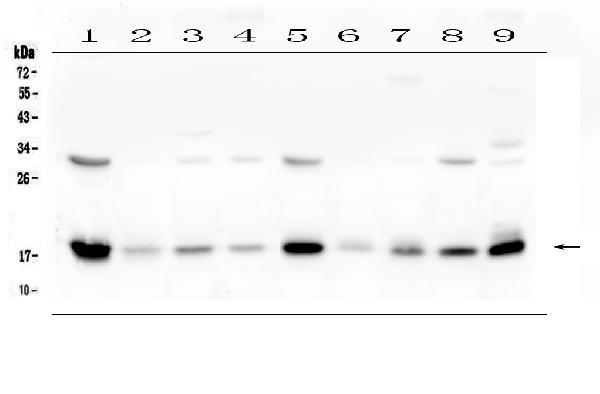
Click image to see more details
Figure 1. Western blot analysis of TIMM17A using anti-TIMM17A antibody (A12168-1).
Electrophoresis was performed on a 5-20% SDS-PAGE gel at 70V (Stacking gel) / 90V (Resolving gel) for 2-3 hours. The sample well of each lane was loaded with 50ug of sample under reducing conditions.
Lane 1: rat heart tissue lysates,
Lane 2: rat lung tissue lysates,
Lane 3: rat liver tissue lysates,
Lane 4: rat brain tissue lysates,
Lane 5: mouse heart tissue lysates,
Lane 6: mouse lung tissue lysates,
Lane 7: mouse liver tissue lysates,
Lane 8: mouse brain tissue lysates,
Lane 9: mouse Neuro-2a whole cell lysates,
After Electrophoresis, proteins were transferred to a Nitrocellulose membrane at 150mA for 50-90 minutes. Blocked the membrane with 5% Non-fat Milk/ TBS for 1.5 hour at RT. The membrane was incubated with rabbit anti-TIMM17A antigen affinity purified polyclonal antibody (Catalog # A12168-1) at 0.5 μg/mL overnight at 4°C, then washed with TBS-0.1%Tween 3 times with 5 minutes each and probed with a goat anti-rabbit IgG-HRP secondary antibody at a dilution of 1:10000 for 1.5 hour at RT. The signal is developed using an Enhanced Chemiluminescent detection (ECL) kit (Catalog # EK1002) with Tanon 5200 system. A specific band was detected for TIMM17A at approximately 18KD. The expected band size for TIMM17A is at 18KD.
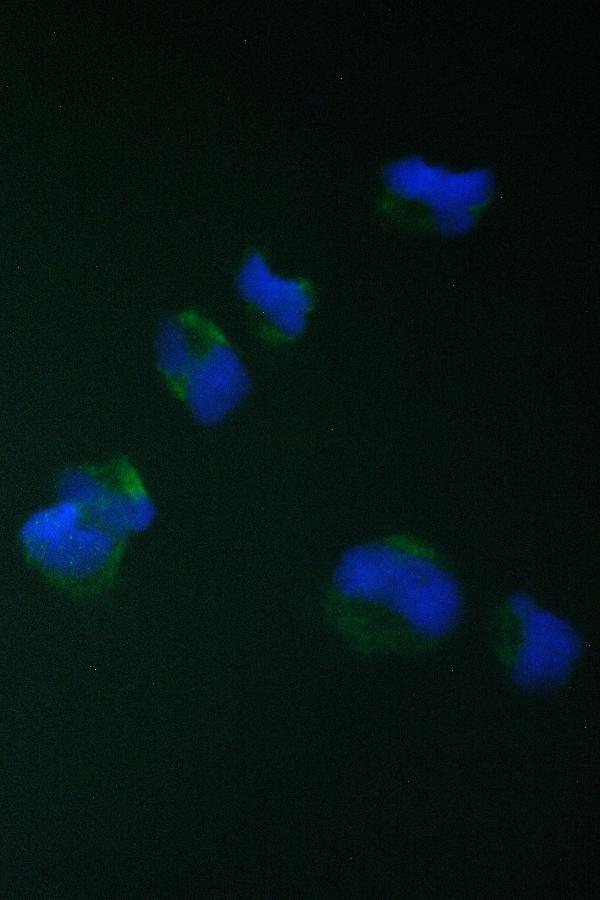
Click image to see more details
Figure 10. IF analysis of TIMM17A using anti-TIMM17A antibody (A12168-1).
TIMM17A was detected in immunocytochemical section of HELA cell. Enzyme antigen retrieval was performed using IHC enzyme antigen retrieval reagent (AR0022) for 15 mins. The cells were blocked with 10% goat serum. And then incubated with 2μg/mL rabbit anti-TIMM17A Antibody (A12168-1) overnight at 4°C. DyLight®488 Conjugated Goat Anti-Rabbit IgG (BA1127) was used as secondary antibody at 1:100 dilution and incubated for 30 minutes at 37°C. The section was counterstained with DAPI. Visualize using a fluorescence microscope and filter sets appropriate for the label used.
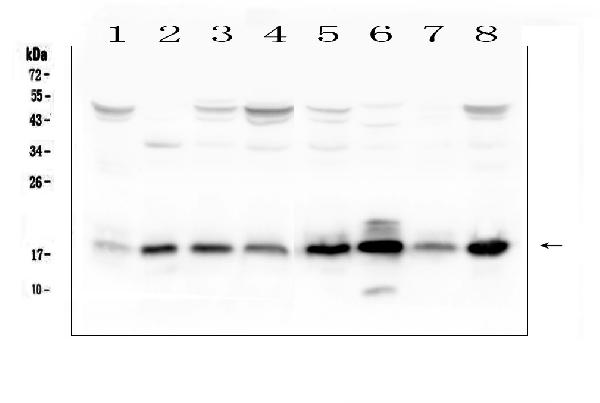
Click image to see more details
Figure 2. Western blot analysis of TIMM17A using anti-TIMM17A antibody (A12168-1).
Electrophoresis was performed on a 5-20% SDS-PAGE gel at 70V (Stacking gel) / 90V (Resolving gel) for 2-3 hours. The sample well of each lane was loaded with 50ug of sample under reducing conditions.
Lane 1: human placenta tissue lysates,
Lane 2: human K562 whole cell lysates,
Lane 3: human T-47D whole cell lysates,
Lane 4: human Caco-2 whole cell lysates,
Lane 5: human Hela whole cell lysates,
Lane 6: human THP-1 whole cell lysates,
Lane 7: human A431 whole cell lysates,
Lane 8: human A549 whole cell lysates.
After Electrophoresis, proteins were transferred to a Nitrocellulose membrane at 150mA for 50-90 minutes. Blocked the membrane with 5% Non-fat Milk/ TBS for 1.5 hour at RT. The membrane was incubated with rabbit anti-TIMM17A antigen affinity purified polyclonal antibody (Catalog # A12168-1) at 0.5 μg/mL overnight at 4°C, then washed with TBS-0.1%Tween 3 times with 5 minutes each and probed with a goat anti-rabbit IgG-HRP secondary antibody at a dilution of 1:10000 for 1.5 hour at RT. The signal is developed using an Enhanced Chemiluminescent detection (ECL) kit (Catalog # EK1002) with Tanon 5200 system. A specific band was detected for TIMM17A at approximately 18KD. The expected band size for TIMM17A is at 18KD.
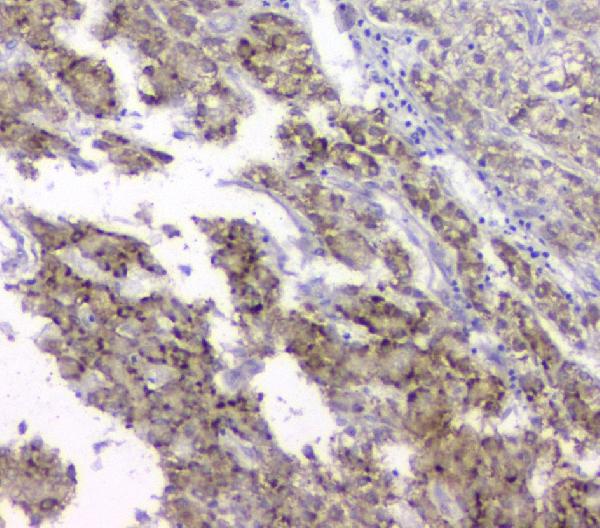
Click image to see more details
Figure 3. IHC analysis of TIMM17A using anti-TIMM17A antibody (A12168-1).
TIMM17A was detected in paraffin-embedded section of human liver cancer tissue. Heat mediated antigen retrieval was performed in citrate buffer (pH6, epitope retrieval solution) for 20 mins. The tissue section was blocked with 10% goat serum. The tissue section was then incubated with 1μg/ml rabbit anti-TIMM17A Antibody (A12168-1) overnight at 4°C. Biotinylated goat anti-rabbit IgG was used as secondary antibody and incubated for 30 minutes at 37°C. The tissue section was developed using Strepavidin-Biotin-Complex (SABC)(Catalog # SA1022) with DAB as the chromogen.
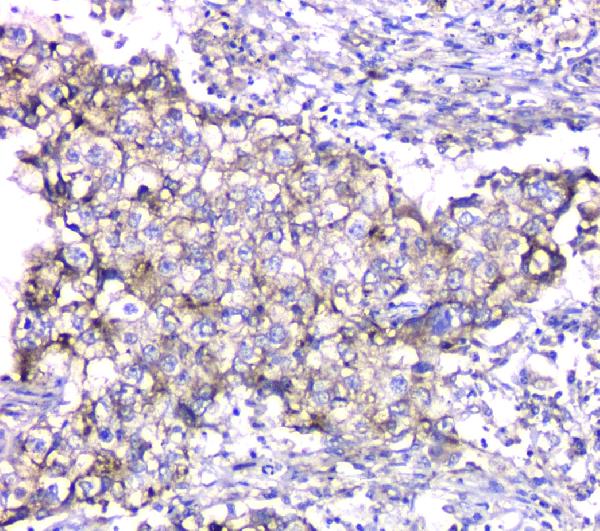
Click image to see more details
Figure 4. IHC analysis of TIMM17A using anti-TIMM17A antibody (A12168-1).
TIMM17A was detected in paraffin-embedded section of human lung cancer tissue. Heat mediated antigen retrieval was performed in citrate buffer (pH6, epitope retrieval solution) for 20 mins. The tissue section was blocked with 10% goat serum. The tissue section was then incubated with 1μg/ml rabbit anti-TIMM17A Antibody (A12168-1) overnight at 4°C. Biotinylated goat anti-rabbit IgG was used as secondary antibody and incubated for 30 minutes at 37°C. The tissue section was developed using Strepavidin-Biotin-Complex (SABC)(Catalog # SA1022) with DAB as the chromogen.
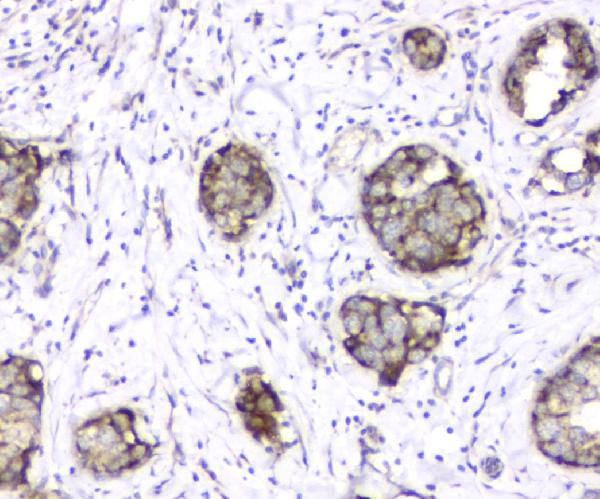
Click image to see more details
Figure 5. IHC analysis of TIMM17A using anti-TIMM17A antibody (A12168-1).
TIMM17A was detected in paraffin-embedded section of human mammary cancer tissue. Heat mediated antigen retrieval was performed in citrate buffer (pH6, epitope retrieval solution) for 20 mins. The tissue section was blocked with 10% goat serum. The tissue section was then incubated with 1μg/ml rabbit anti-TIMM17A Antibody (A12168-1) overnight at 4°C. Biotinylated goat anti-rabbit IgG was used as secondary antibody and incubated for 30 minutes at 37°C. The tissue section was developed using Strepavidin-Biotin-Complex (SABC)(Catalog # SA1022) with DAB as the chromogen.
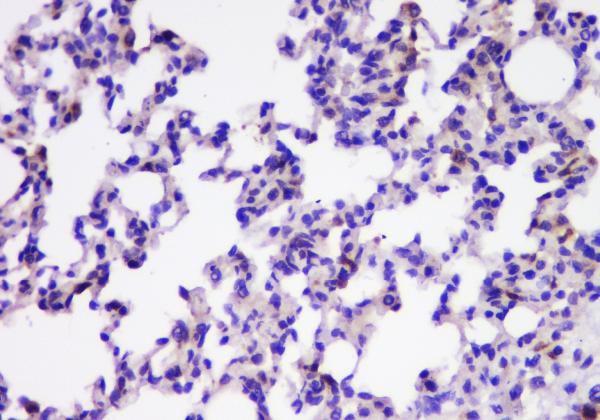
Click image to see more details
Figure 6. IHC analysis of TIMM17A using anti-TIMM17A antibody (A12168-1).
TIMM17A was detected in paraffin-embedded section of rat lung tissue. Heat mediated antigen retrieval was performed in citrate buffer (pH6, epitope retrieval solution) for 20 mins. The tissue section was blocked with 10% goat serum. The tissue section was then incubated with 1μg/ml rabbit anti-TIMM17A Antibody (A12168-1) overnight at 4°C. Biotinylated goat anti-rabbit IgG was used as secondary antibody and incubated for 30 minutes at 37°C. The tissue section was developed using Strepavidin-Biotin-Complex (SABC)(Catalog # SA1022) with DAB as the chromogen.
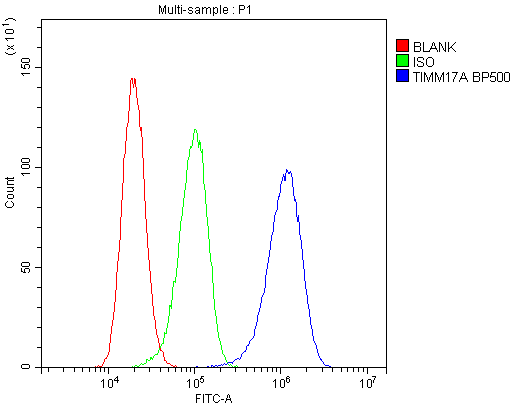
Click image to see more details
Figure 7. Flow Cytometry analysis of A431 cells using anti-TIMM17A antibody (A12168-1).
Overlay histogram showing A431 cells stained with A12168-1 (Blue line). To facilitate intracellular staining, cells were fixed with 4% paraformaldehyde and permeabilized with permeabilization buffer. The cells were blocked with 10% normal goat serum. And then incubated with rabbit anti-TIMM17A Antibody (A12168-1,1μg/1x106 cells) for 30 min at 20°C. DyLight®488 conjugated goat anti-rabbit IgG (BA1127, 5-10μg/1x106 cells) was used as secondary antibody for 30 minutes at 20°C. Isotype control antibody (Green line) was rabbit IgG (1μg/1x106) used under the same conditions. Unlabelled sample (Red line) was also used as a control.
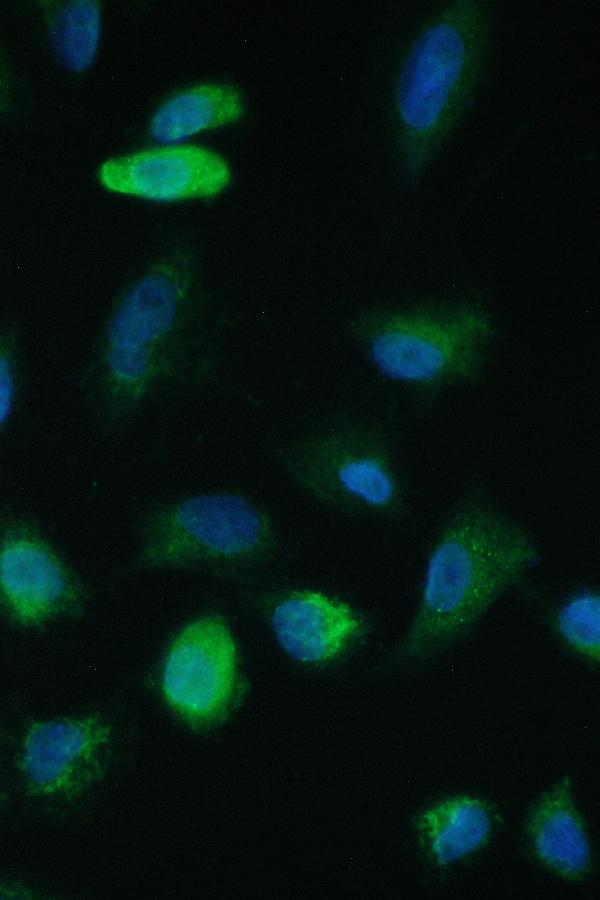
Click image to see more details
Figure 8. IF analysis of TIMM17A using anti-TIMM17A antibody (A12168-1).
TIMM17A was detected in immunocytochemical section of A549 cell. Enzyme antigen retrieval was performed using IHC enzyme antigen retrieval reagent (AR0022) for 15 mins. The cells were blocked with 10% goat serum. And then incubated with 2μg/mL rabbit anti-TIMM17A Antibody (A12168-1) overnight at 4°C. DyLight®488 Conjugated Goat Anti-Rabbit IgG (BA1127) was used as secondary antibody at 1:100 dilution and incubated for 30 minutes at 37°C. The section was counterstained with DAPI. Visualize using a fluorescence microscope and filter sets appropriate for the label used.
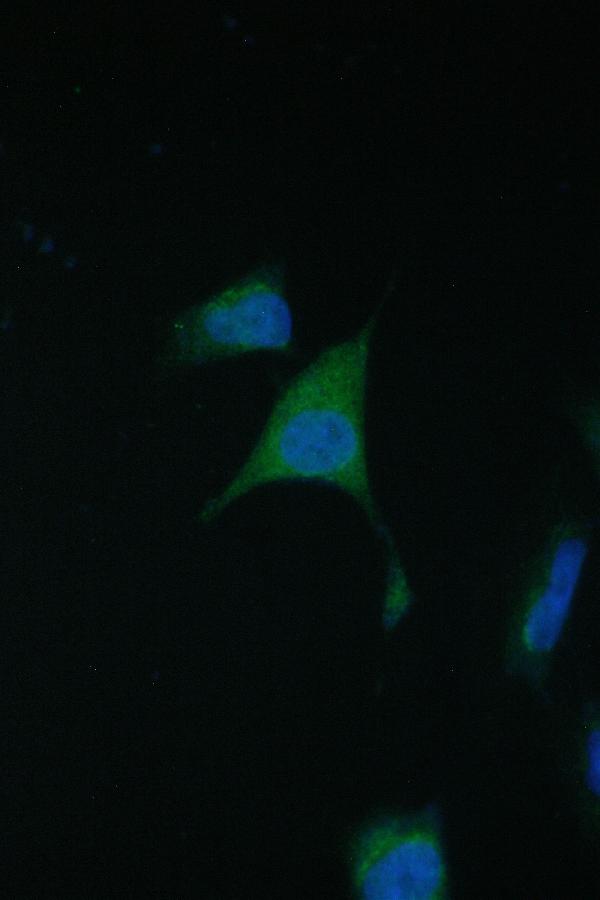
Click image to see more details
Figure 9. IF analysis of TIMM17A using anti-TIMM17A antibody (A12168-1).
TIMM17A was detected in immunocytochemical section of A549 cell. Enzyme antigen retrieval was performed using IHC enzyme antigen retrieval reagent (AR0022) for 15 mins. The cells were blocked with 10% goat serum. And then incubated with 2μg/mL rabbit anti-TIMM17A Antibody (A12168-1) overnight at 4°C. DyLight®488 Conjugated Goat Anti-Rabbit IgG (BA1127) was used as secondary antibody at 1:100 dilution and incubated for 30 minutes at 37°C. The section was counterstained with DAPI. Visualize using a fluorescence microscope and filter sets appropriate for the label used.

Click image to see more details
Figure 11. IHC analysis of TIMM17A using anti-TIMM17A antibody (A12168-1).
TIMM17A was detected in paraffin-embedded section of mouse lung tissues. Heat mediated antigen retrieval was performed in citrate buffer (pH6, epitope retrieval solution) for 20 mins. The tissue section was blocked with 10% goat serum. The tissue section was then incubated with 1μg/ml rabbit anti-TIMM17A Antibody (A12168-1) overnight at 4°C. Biotinylated goat anti-rabbit IgG was used as secondary antibody and incubated for 30 minutes at 37°C. The tissue section was developed using Strepavidin-Biotin-Complex (SABC)(Catalog # SA1022) with DAB as the chromogen.
Protein Target Info & Infographic
Gene/Protein Information For TIMM17A (Source: Uniprot.org, NCBI)
Gene Name
TIMM17A
Full Name
Mitochondrial import inner membrane translocase subunit Tim17-A
Weight
18.024kDa
Superfamily
Tim17/Tim22/Tim23 family
Alternative Names
Mitochondrial import inner membrane translocase subunit Tim17-A; Inner membrane preprotein translocase Tim17a; TIMM17A; MIMT17; TIM17; TIM17A; TIMM17 TIMM17A TIM17, TIM17A translocase of inner mitochondrial membrane 17A mitochondrial import inner membrane translocase subunit Tim17-A|inner membrane preprotein translocase Tim17a|mitochondrial inner membrane translocase|preprotein translocase|translocase of inner mitochondrial membrane 17 homolog A
*If product is indicated to react with multiple species, protein info is based on the gene entry specified above in "Species".For more info on TIMM17A, check out the TIMM17A Infographic

We have 30,000+ of these available, one for each gene! Check them out.
In this infographic, you will see the following information for TIMM17A: database IDs, superfamily, protein function, synonyms, molecular weight, chromosomal locations, tissues of expression, subcellular locations, post-translational modifications, and related diseases, research areas & pathways. If you want to see more information included, or would like to contribute to it and be acknowledged, please contact [email protected].
Specific Publications For Anti-TIMM17A Antibody Picoband® (A12168-1)
Hello CJ!
No publications found for A12168-1
*Do you have publications using this product? Share with us and receive a reward. Ask us for more details.
Recommended Resources
Here are featured tools and databases that you might find useful.
- Boster's Pathways Library
- Protein Databases
- Bioscience Research Protocol Resources
- Data Processing & Analysis Software
- Photo Editing Software
- Scientific Literature Resources
- Research Paper Management Tools
- Molecular Biology Software
- Primer Design Tools
- Bioinformatics Tools
- Phylogenetic Tree Analysis
Customer Reviews
Have you used Anti-TIMM17A Antibody Picoband®?
Submit a review and receive an Amazon gift card.
- $30 for a review with an image
0 Reviews For Anti-TIMM17A Antibody Picoband®
Customer Q&As
Have a question?
Find answers in Q&As, reviews.
Can't find your answer?
Submit your question
5 Customer Q&As for Anti-TIMM17A Antibody Picoband®
Question
Does A12168-1 anti-TIMM17A antibody work on parafin embedded sections? If so, which fixation method do you recommend we use (PFA, paraformaldehyde, other)?
Verified Customer
Verified customer
Asked: 2019-12-31
Answer
It shows on the product datasheet, A12168-1 anti-TIMM17A antibody as been tested on Flow Cytometry. It is best to use PFA for fixation because it has better tissue penetration ability. PFA needs to be prepared fresh before use. Long term stored PFA turns into formalin, as the PFA molecules congregate and become formalin.
Boster Scientific Support
Answered: 2019-12-31
Question
We are currently using anti-TIMM17A antibody A12168-1 for rat tissue, and we are well pleased with the IHC-P results. The species of reactivity given in the datasheet says human, mouse, rat. Is it likely that the antibody can work on pig tissues as well?
A. Kulkarni
Verified customer
Asked: 2019-11-18
Answer
The anti-TIMM17A antibody (A12168-1) has not been tested for cross reactivity specifically with pig tissues, but there is a good chance of cross reactivity. We have an innovator award program that if you test this antibody and show it works in pig you can get your next antibody for free. Please contact me if I can help you with anything.
Boster Scientific Support
Answered: 2019-11-18
Question
Is this A12168-1 anti-TIMM17A antibody reactive to the isotypes of TIMM17A?
Verified Customer
Verified customer
Asked: 2018-03-27
Answer
The immunogen of A12168-1 anti-TIMM17A antibody is A synthetic peptide corresponding to a sequence of human TIMM17A(LFSMIDCSMVQVRGKED). Could you tell me which isotype you are interested in so I can help see if the immunogen is part of this isotype?
Boster Scientific Support
Answered: 2018-03-27
Question
Would anti-TIMM17A antibody A12168-1 work for Flow Cytometry with skeletal muscle?
Verified Customer
Verified customer
Asked: 2018-01-24
Answer
According to the expression profile of skeletal muscle, TIMM17A is highly expressed in skeletal muscle. So, it is likely that anti-TIMM17A antibody A12168-1 will work for Flow Cytometry with skeletal muscle.
Boster Scientific Support
Answered: 2018-01-24
Question
Does anti-TIMM17A antibody A12168-1 work on primate IF with skeletal muscle?
Verified Customer
Verified customer
Asked: 2017-06-09
Answer
Our lab technicians have not tested anti-TIMM17A antibody A12168-1 on primate. You can run a BLAST between primate and the immunogen sequence of anti-TIMM17A antibody A12168-1 to see if they may cross-react. If the sequence homology is close, then you can perform a pilot test. Keep in mind that since we have not validated primate samples, this use of the antibody is not covered by our guarantee. However we have an innovator award program that if you test this antibody and show it works in primate skeletal muscle in IF, you can get your next antibody for free.
Boster Scientific Support
Answered: 2017-06-09





